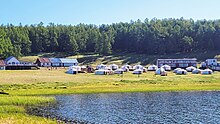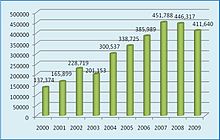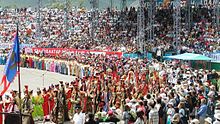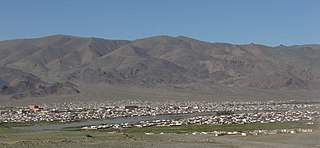This article has multiple issues. Please help improve it or discuss these issues on the talk page . (Learn how and when to remove these template messages)
|

Tourism in Mongolia was extremely limited by the Socialist Government, but has been expanding following the 1990 Democratic Revolution in Mongolia in the wake of the collapse of the USSR and the Revolutions of 1989. Mongolia is a unique and relatively unexplored travel destination that offers a great combination of scenic natural features, a wide variety of untouched landscapes, nomadic life style and culture. Travel organizations in Mongolia date back to half a century ago, but the private sector-based tourism is barely twenty years old. Now Mongolia boasts 403 travel companies, 320 hotels, 647 resorts and tourist camps, all employing the graduates from over 56 educational establishments. [1] Mongolia takes an active part in United Nations World Tourism Organization, of which it is a member party.
Contents

To boost foreign investment in tourism, the Government of Mongolia offers special tax exemption equaling up to 10 percent of the total investment if offered for construction of high-rated hotels and tourist complexes. Licenses for tourism business were abolished and service provided by tour operators for expatriate visitors is now exempt from VAT. Standards and regulations are largely non-restrictive, with no complicated layers of bureaucracy issuing permission and exercising control.
A vivid example of the successful reform of the legal framework is the progressive increase of the number of visitors – the number reaching 450,000 in 2010 - tripling the 2000 estimate. [2] With one of the world's lowest population densities, the vastness of the Mongolian-Manchurian grassland, desert, as well as the numerous mountains, rivers and lakes offer plenty of adventure. Although backpacking is becoming more common, travel outside Ulanbataar is mostly arranged by tour operator companies.

In January 2013, the Ministry of Culture, Sport and Tourism of Mongolia approved official slogan for Mongolia's tourism called “Go Nomadic, Experience Mongolia”[ citation needed ] which, it believes, will properly position help boost tourism industry in Mongolia. However, after a year the Ministry replaced the official slogan to new "Mongolia - Nomadic by Nature.[ citation needed ]
On March 5, 2014, during ITB Berlin 2014 exhibition in Germany, officials from the Ministry of Culture, Sports and Tourism of Mongolia signed an agreement to become official partner country for ITB Berlin 2015. [3]
The Ministry of Culture, Sport and Tourism of Mongolia has been restructured into the Ministry of Environment, Green Development and Tourism in December, 2014 as a result of country's government cabinet change.[ citation needed ]
Activity travels available include trekking, climbing, bird watching, horse riding, rafting, camel riding, yak caravan and overland motorcycle tours. Many of these tours focus strongly on ecology and wildlife, and almost all of them include the Gobi Desert as one of their destinations; apart from its numerous native animal species, the desert is famous for its fossilised dinosaur bones and eggs. Mongolia's lakes represent another good hiking destination, as do the Four Holy Peaks surrounding Ulaanbaatar or the Gobi Gurvansaikhan National Park, in the Umnugobi. [4] The economy of Mongolia is expecting "unstoppable" growth as its natural resources are tapped, [5] which will enable further investment in infrastructure.
In 2023, Mongolia decided to promote tourism and allow visitors from 34 countries enter the country visa-free until the end of 2025. [6] Among the countries which citizens can enter Mongolia visa-free are all the European Union countries (except for Germany, which have already had visa-free entry to Mongolia), UK, Australia and New Zealand. [7]















